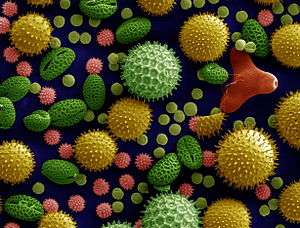Pollen count
A pollen count is the measurement of the number of grains of pollen in a cubic meter of air. High pollen counts can sometimes lead to increased rates of an allergic reaction for those with allergic disorders. Usually, the counts are announced for specific plants such as grass, ash, or olive. These are tailored to common plants in the measured areas. Mild winters with warmer days lead to an increase in pollen counts[1] while colder winters lead to delayed pollen release.[1]

In the UK, the public announcement of the pollen count was popularised by Dr. William Frankland, an immunologist.
According to a study by Leonard Bielory, M.D. that was presented to the American College of Allergy, Asthma & Immunology, climate changes are expected to cause pollen counts to more than double by 2040.[2]
Methods
One method of taking the sample uses a silicone grease-covered rod, rotated in the air to collect the pollen. The rod is rotated periodically during the collection period to gather samples through an entire 24-hour day. The rod is then removed and taken to a lab where the collected material is analyzed for the type of pollen and its concentration.
Another method for measuring the pollen count is by using a Burkard Trap, also known as the seven-day volumetric spore trap.[3][4] This device works by facing towards the wind and drawing in air by using a pump. The pollen particles drawn in by the pump are then trapped by a sticky wax film that is attached to a rotating drum. The drum slowly rotates one turn over the course of seven days while collecting particles. The tape is removed after one week and cut into day-length sections.
See also
- National Pollen and Aerobiology Research Unit – the world's first pollen forecasting service
References
- Skinner, Anne (Aug 6, 2016). "What is Pollen?" (PDF). Master Gardener Newspaper.
- "The Year 2040: Double the Pollen, Double the Allergy Suffering?".
- Latałowa, Małgorzata; Miętus, Mirosław; Uruska, Agnieszka (2002-03-01). "Seasonal variations in the atmospheric Betula pollen count in Gdańsk (southern Baltic coast) in relation to meteorological parameters". Aerobiologia. 18 (1): 33–43. doi:10.1023/A:1014905611834. ISSN 0393-5965.
- Lacey, Maureen E.; West, Jonathan S. (2006). The Air Spora - Springer. doi:10.1007/978-0-387-30253-9. ISBN 978-0-387-30252-2.
External links